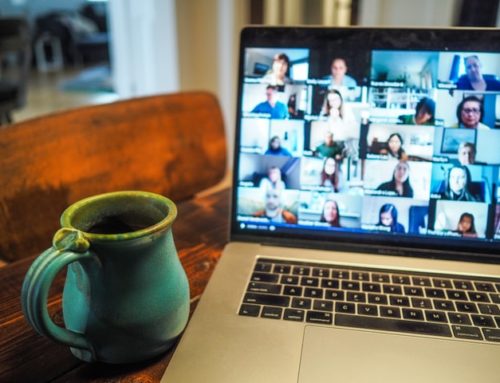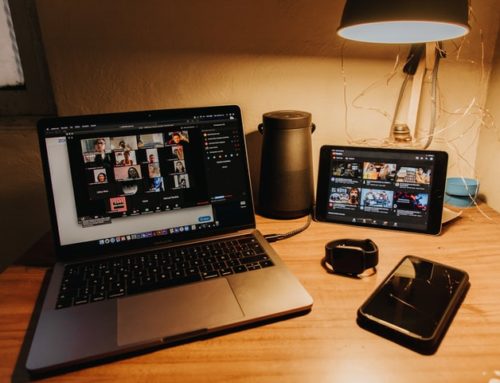Have you heard the coronavirus?
It turns out that the structure of the novel coronavirus’s spike protein, when set to music, is beautiful (Figure 1). MIT scientists have used a technique called “sonification” to assign musical notes to each amino acid, which can apparently help scientists locate “sites on the protein where antibodies or drugs might be able to bind” (Venugopal 2020). I’m listening to the virus as I write: it is meditative, lilting, occasionally discordant, and then suddenly disturbing, jangled, jarring. Listening to the coronavirus offers another perspective.

Figure 1: Listening to the Coronavirus (posted on Science)
Perspective: a central tool cultural anthropology offers us to learn from and about dimensions of experience that we little understand. As the pandemic unfolded, I was following the artist Karma Phuntsok’s work on a painting he entitled TARA. He uploaded an image of the completed painting to Facebook on May 7, 2020. At the end of March, he had posted a close-up detail from the in-progress work, showing Earth decentered and diminutive below his floating bodhisattva: “The more ‘Karuna’ [compassion], the less corona virus.”1

Figure 2: TARA, by Karma Phuntsok
Sometimes gifts from the universe, like Karma Phuntsok’s work, offer us the scope to see outside ourselves (Figure 2). Other times, lingering—wallowing, even—in moments of anxiety, boredom, dis/ease—end up yielding perspective that might even be healing, without us knowing it.
When it had become apparent that nothing would be the same in the spring 2020 semester, I offered my Introduction to Cultural Anthropology students an extra credit opportunity: to write five COVIDiaries, according to the principles of expressive writing designed by psychologist James Pennebaker at the University of Texas at Austin.2 My students were familiar with Pennebaker’s work. Earlier in the semester, in a class unit focusing on narrative and storytelling, we had discussed the ways that narrative interpretation and its social dimensions shape (rather than merely reflect) our experience in the world. Juxtaposing Arthur Kleinman’s (1988) concept of illness narratives with an NPR piece on “story editing,” I highlighted to the students the ways that our engagement with narrative practices impact both our world view and our well-being.3
Pennebaker’s work shows that short free-writing exercises can benefit immune function. In his interventions with undergraduates, students spent fifteen minutes for five sequential days free-writing on any topic that was bothering them. Over the course of their time in college, students who undertook this intervention had fewer visits to health services than the control group. Of course, it’s possible that writing on a disturbing topic might merely focus a person’s attention to it or cause re-traumatization. But Pennebaker has argued that through writing, people make sense of disturbing events and put them into context, and this process—like cognitive behavioral therapy—decreases stress, which in turn supports health (Murray 2002). Writers shift their own frame of analysis, sometimes producing narratives that enable them to understand destabilizing shifts as part of a life trajectory (what Cheryl Mattingly (1998) has called “narrative emplotment”; see also Ochs and Capps 1996). They gain a new perspective.
Perspective was rather a lot to ask of the situation. But if there was ever a time the students could use boosted immune function, I figured, it was now.
I invited the students to free-write for fifteen minutes during five separate sessions on the below topics, and submit these COVIDiaries for extra credit. I prompted them to consider:
• How has Coronavirus impacted you and those you love, socially, physically, mentally?
• Reflect on cultural and political dimensions of this experience
• What are ways to create social care during “social distancing”?
• …or any other topic!
Out of a class of 155, seventy-six students submitted at least one COVIDiary, and those who submitted tended to write four or five. I had been lamenting how little I had come to know the students before the class went remote. But reading these submissions offered an intimate glimpse into their lives in the manner of a sustained Zoom call. It was a narrow frame that still illuminated humorously, and somewhat self-consciously, unpolished selves. The “quarantine couture” sweatpants were in full view. This glimpse was of course at least minimally cultivated (properly panoptic, the students did not know if anyone would read their posts—these were for a completion grade).
Many of the posts made me chuckle. Some made me cry. I emailed some students to check up on them, although, like their own posts, I didn’t know if my missive would be read, if the communicative channel was in operation. I wanted merely a signal, as in the artist On Kawara’s telegrams sent to acquaintances in the 1970s, with the single line, “I am still alive” (Nozawa 2015).
The sociality inherent in this mode of communication-to-oneself, where some “other” (professor or TA) may or may not be a reader, is ambient, affective, uncertain. Students sometimes addressed their entries to a Diary, some to the coronavirus itself, and some directly addressed a hypothetical reader. They assured me/someone that they would follow up, promising to report in the next entry whether a sore throat lingered. People expressed hopes that the reader, if reader read, was doing well. Some thanked me directly for the opportunity to write; some thanked a reader for listening. Many apologized for concerns and frustrations they understood as petty or trivial.
“If you’re reading this…”
The earliest posts were submitted in mid-March; the last date for submission was May 6. Particularly in initial diaries, there was a lot of anger for all that had been suddenly snatched away: being with friends, being with significant others, being in class in-person with classmates and professors. Being able to celebrate graduation. Anger at the American President; anger at people who did not respect social distancing and went out without masks. There was also lassitude. Really, why get up? A claustrophobia of confinement with more sorrow than restlessness. Eating because there was nothing else to do. Alcohol, because why not? So much coffee. A sense of unreality, a stretching and condensing of time. Heightened attention to bodily sensation, and anxiety regarding bodily sensation. Losing a job and having enough in the bank either for one month’s rent, or for food.
A kind of gathering up, rousing, wakening of initiative. Making up exercise routines in the living room, despite an absence of equipment. Going outside finally/ all the time/ with a mask/ without a mask. Painting, writing poetry. Cooking elaborate meals for one, as leftovers filled the refrigerator.
The COVIDiaries tracked stages of movement over time and within relational context: people swiftly going home to parents’ houses, or staying put and feeling stuck and then going home, or going home and then returning to Boulder. Musings about where “home” even was anymore. Gratitude for time spent with siblings and parents. Realizing that one’s own body was an unacceptable risk to a grandparent. Kin dying, whether or not from Covid-19, and being mourned without funerals. New pets. Deciding when to argue about dishes and bathrooms, and how to reciprocate the gift of a meal. Realizing that one never had given enough time to oneself, had never done enough for oneself, had never decided enough for oneself. Being engaged in or witness to bitter feuds. Reconsidering priorities, people, and activities. Does college really have to be as stressful as it is? The never-ending drone of news coming from a family member’s television. Arguments with family members about politics. Bubble baths. Enjoying writing these COVIDiaries which are even for extra credit! Enjoying this pause. Wanting this whole thing to be over. Being scared of other people yet craving contact. A sense of disconnection from others. A sense of connection to others, being surprised by that connection.
I was charmed by the polyvocality of the pieces as I read them one after another, the vibrancy of the students’ voices, by their humor and hope. One student closed an entry, “Overall it was a good day and I am fortunate for it.”
Their despair sometimes felt too immediate. The accounts inevitably ended too quickly, an abruptness mirroring the totality of the disjuncture wrought on these students’ lives by the virus itself. The person whose mother, an emergency room employee, had become ill. Her virus test was negative, to the relief of her family. But the student wrote only four, not five, posts. What might have happened in that family after the fourth submission? Another student who, also in a fourth post, described bizarre symptoms, a body made strange, wracking fear. There wasn’t a fifth post. Those with learning disabilities reflecting on their struggles to succeed in in-person classes. What would the fall bring, how could they survive school if online education prevailed? Everything had changed.
COVIDiary entries oscillated between scales of attunement and perspective. Many wrote about “silver linings.” One person noted that the pandemic has a purpose: it is necessary for the world, for the animals, for the environment. It is terrifying for the humans.
The music of the coronavirus protein starts out fluid and lilting, decent company for writing. Around minute forty, it turns violent, a visceral shock. I turned it off. Like the rest of the world, my students and I are too in the middle of it all to place anything into coherent context. Yet it is possible to cultivate modes of attention to different scales of experience, from the structure of a virus protein to a Buddhist cosmology of compassion. That is difficult and worthwhile labor.
In a recent rare interview, the Estonian composer Arvo Pärt noted, “This tiny coronavirus has showed us in a painful way that humanity is a single organism and human existence is possible only in relation to other living beings. The notion of ‘relationship’ should be understood as a maxim, as the ability to love. Although this is truly a high standard, maybe even too high for a human being.”4 I leave you with Pärt, rather than the coronavirus, as accompaniment to these reflections.
To my students, if you are reading this: Thank you for sharing glimpses of your experience with me, and with us. As one of you concluded, “Until next time, corona diary. Thanks for listening!”
Notes:
[1] https://www.facebook.com/karma.phuntsok.art, March 20, 2020.
[2] https://liberalarts.utexas.edu/psychology/faculty/pennebak#writing-health
References:
Kleinman, Arthur. 1988. The Illness Narratives: Suffering, Healing, and the Human Condition. New York: Basic Books.
Mattingly, Cheryl. 1998. Healing Dramas and Clinical Plots: The Narrative Structure of Experience. Cambridge: Cambridge University Press.
Murray, Bridget. 2002. “Writing to Heal.” Monitor on Psychology 33(6), June. http://www.apa.org/monitor/jun02/writing
Nozawa, Shunsuke. 2015. “Phatic Traces: Sociality in Contemporary Japan.” Anthropological Quarterly 88(2): 373-400.
Ochs, Elinor and Lisa Capps. 1996. “Narrating the Self.” Annual Review of Anthropology 25(1): 19-43.
Venugopal, Vineeth. 2020. “Scientists have turned the structure of the coronavirus into music.” Science, Apr. 3. doi:10.1126/science.abc0657
Karma Phuntsok’s website: http://www.karmaart.com/index.htm
Cite as: Goldfarb, Kathryn E. 2020. “Dear COVIDiaries: Freewriting as Pandemic Pedagogy.” In “Pandemic Diaries,” Gabriela Manley, Bryan M. Dougan, and Carole McGranahan, eds., American Ethnologist website, May 16 2020, [https://americanethnologist.org/features/pandemic-diaries/teaching-right-now/boulder-dear-covidiaries-freewriting-as-pandemic-pedagogy]
Kathryn E. Goldfarb is assistant professor of anthropology at the University of Colorado. Her research focuses on kinship, embodiment, and well-being.




